Since 1994, Cascadia’s largest city, Seattle, has subjected most of its new apartment construction to “design review,” in which building proposals must win approval from a volunteer citizen board. But if there’s no accounting for taste, is it realistic to think a city can enforce good design through a process reliant on a consensus of subjective opinions? How new buildings look is one thing, but what are possible unseen drawbacks of this kind of process?
Consider the building pictured above, located in Seattle’s Ballard neighborhood. My architect friends agree that it’s a cringeworthy cut-and-paste of clashing aesthetics that looks like it was designed by a committee of amateurs. Then again, some people like the building just fine. And it got the thumbs up from design review.
Fortunately, Seattle’s design review program is not exclusively aimed at the dubious task of policing aesthetics. Board members assess the uses of buildings, their connections with the surrounding community, and if they conform to city plans. Perhaps most importantly, boards can grant builders exceptions to rules when doing so will advance the city’s broader planning goals.
As Cascadia’s affordable housing crunch has intensified over recent years, design review has come under greater scrutiny, especially in Seattle. The delay it causes impedes homebuilding, including subsidized affordable housing, and drives up rents—unintended consequences that no city has the luxury to ignore. As bad, residents alarmed at the pace of change in Seattle have increasingly coopted design review to block new housing in their neighborhoods. For these reasons, Seattle’s 2015 Housing Affordability and Livability Agenda recommended revamping the program, and the city council is currently debating proposed legislation.
In this article, I dig into design review Seattle-style: how it works and how the city proposes to improve it; how that proposal falls short and how to fix it; and how to radically overhaul design review to provide the predictability and efficiency appropriate for a city battling an affordability crisis caused by a chronic shortage of homes. Spoiler: the ultimate solution lies in Vancouver, BC, where senior city staffers, not volunteer boards, review and approve building designs.
How Seattle’s design review works
Instituted in 1994, Seattle’s design review program offers three types of review: full, administrative and streamlined (in order from most intensive review to least), the applicable type dictated in most cases by the size of the proposed building. During 2014 and 2015, almost two thirds of projects that went through review went through full design review, nearly one third through streamlined design review, and the remaining few percent through administrative design review. The latter two types are handled by city staff and do not involve citizen boards or public meetings.
Full design review applies to all but the smallest of the city’s multifamily developments, and therefore touches the majority of new homes built in Seattle. The program divides the city into seven districts, each served by its own board. Each board includes city-appointed members who represent five interests: design, development, community, local residents, and local business. Board members receive scant training from the city, and their expertise and experience vary widely.
For full design review, developers present their proposal to the board at public meetings in two phases: “early design guidance” followed by “design recommendation.” In either phase if the board is not satisfied with the proposed design, it can mandate additional meetings, adding months to a project’s timeline. From 2014 to 2015, boards required a quarter of projects to come back for more than one early design guidance meeting, and 15 percent to return for more than one recommendation meeting, and the average time between the developer’s application for an early design guidance meeting and the city’s granting of the primary permit was 11 months.
Design review’s tradeoffs
Seattle’s design review program can improve buildings, although the benefits are difficult to quantify, especially in terms of aesthetics—again, does anyone really believe that it’s possible to legislate beauty?
Design review tends to be most beneficial when the board grants exceptions from the city’s standard design regulations—“departures”—to developers who demonstrate that the allowance would help their building better serve the community. Design review has also reduced counterproductive legal appeals by providing an upfront community forum: in 2014 and 2015 just 2 percent of projects reviewed were appealed.
There are severe tradeoffs, however. As I detailed previously, by the city’s estimate, for a 135-unit apartment building each month of delay racks up $270,000 of expense, roughly equivalent to the construction cost of one apartment. Not all of the delay from start to finish of design review can be blamed on the city’s process: doing the architecture takes time too. Taking that into account, if design review goes smoothly it typically delays projects by perhaps half a year—for the 135-unit example, that’s the cost of six apartments. Every extra meeting required by the board likely adds another two months, at least, sacrificing the value of two more apartments.
Design review’s imposed costs also include preparing for and attending meetings—consultant fees typically run into tens of thousands of dollars per meeting. These expenses inflict a proportionally larger burden on modest projects that have small budgets. On top of that are added construction costs and redesign fees associated with any changes that boards demand, such as more expensive materials or a more intricate building form.
Overall, design review instills uncertainty over the development timeline, a powerful but underappreciated damper on homebuilding. Uncertainty means greater risk, and that makes projects less attractive to investors and more expensive to finance. Board inconsistency is a big contributor: developers cannot predict how a given board will react on any given day. As with any advisory board, some members may feel they aren’t doing their job if they don’t find some fault. Insiders describe how it can become a game, in which architects might hold back their best designs to unveil at subsequent meetings, so as to ensure they can show how they “responded” to the board’s critiques.
There is a genuine desire by community members to have a say in what happens in their neighborhood. But adding to the challenges of design review, in recent years, residents uncomfortable with Seattle’s growth appear to be discovering that it’s a forum at which they can vent and obstruct. And that puts pressure on the volunteer board members to make demands that may reach beyond the purview of design review and capriciously hold up homebuilding.
Design review run amok
The inherent unpredictability of volunteer boards combined with the growing trend of unhappy neighbors swarming meetings adds up to a design review process prone to run amok. Here are some recent examples.
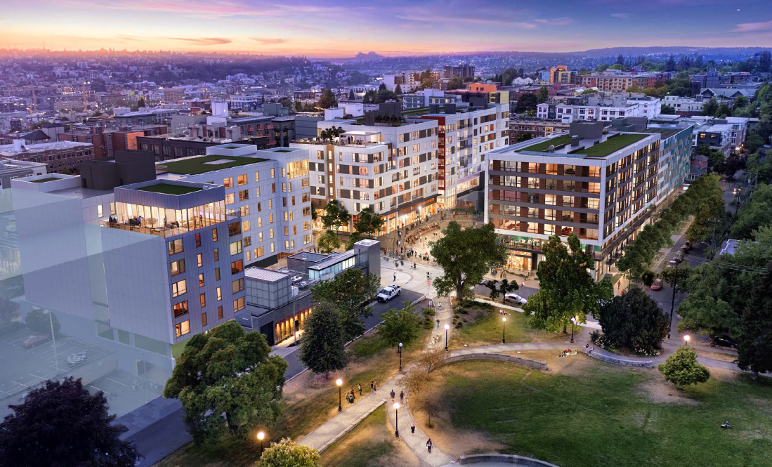
Transit-oriented development at the Capitol Hill light rail station (118 Broadway East)
The culmination of a public process that began nearly a decade ago, this project would provide 400 in-city homes—168 of the apartments would be subsidized, below-market-rate units—in four buildings. In July, the design review board mandated a second recommendation meeting for reasons that verge on the absurd:
- The board wants to pick the color scheme: “I would go with a different color.” “I do think that color is used a lot to spruce up affordable housing.”
- A lone board member is adamant that a daycare should not be allowed on a commercial street: “I still think it’s a terrible idea to put ground-floor childcare on Broadway… frankly, I can’t support the project with this.”
- Echoing an anti-modernist refrain commonly heard in design review meetings, the board feels that some of the building fronts are too monolithic and they want to see more “modulation,” that is, more ins and outs along the exterior walls. (Aesthetically, the all too frequent result is awkward, jumbled styles like the one pictured atop this article. Economically, the guaranteed result is fewer units and a more expensive building: a dual blow to affordability.)
- The board believes that two street-level residential units should be retail spaces instead. (Seattle currently has a glut of street-level retail space going unleased, because land-use codes demand more storefronts than the city’s shoppers will patronize.)
Succumbing to the temptation to play the lofty architecture critic, one board member proclaimed: “This is a really good building. I think we were expecting it to be a great building.” Another declared, “Timeless would be an important quality, I think, for this building.”
So far the design review process has burned nine months, and the extra meeting will add at least two more. The cost of that delay is likely similar to being forced to build an extra 33 apartments and then demolish them—all because five volunteers want to dicker over a color scheme and a daycare entrance.
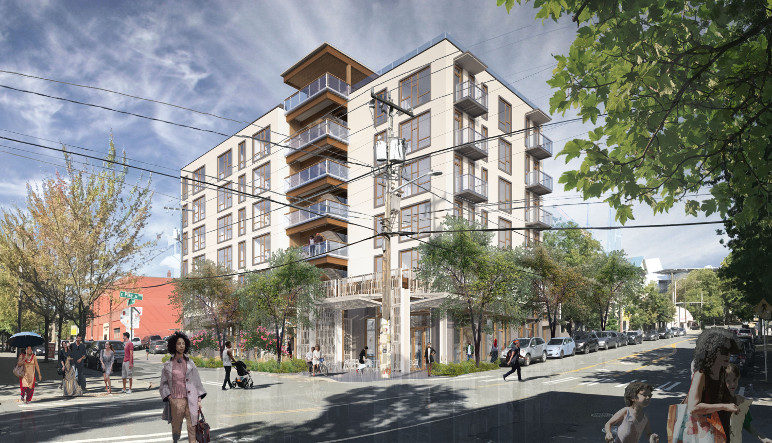
“Passive House” apartments on Capitol Hill (1300 East Pike)
This 6-story, 45-unit project would be the city’s largest apartment building to meet the ultra-stringent, ultra-green Passive House energy standard, a European approach to energy efficiency that is a quantum leap beyond Cascadian energy codes. The board mandated a third meeting primarily over objections to fiber cement siding, a relatively inexpensive, commonly used façade material. The board directed the developer to “explore the use of brick” to achieve a “more historical feel,” disregarding that lower cost siding would help defray the added expense of passive house design. Two months later at the added meeting the board approved the building with the same fiber cement siding and without any brick. The developer expects to receive the final construction permit in September, one year and seven months after first applying for design review. The only thing the “explore brick” feedback did was to drive up the cost of the building, and make future passive house projects marginally less likely.
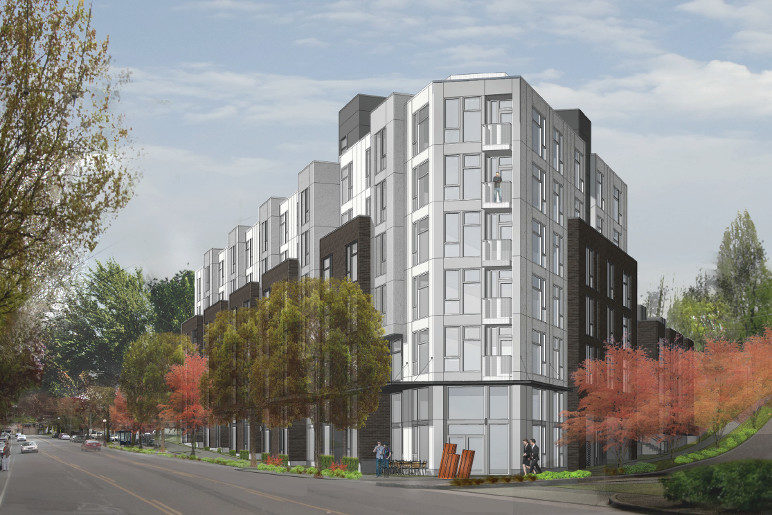
Columbia City apartments (5201 Rainier Ave South)
This 111-unit apartment project requested a “contract rezone” to allow six stories instead of four. Contract rezones and design review are separate processes, but the allowance for a taller building intensified neighborhood opposition. The board was sympathetic to neighbors’ concerns, and demanded that the developer add façade modulation and setbacks, design moves that some people feel make buildings seem smaller. The result is 11 fewer homes in the building—a nine percent loss of rent income—along with a construction cost increase of 3 to 5 percent, not to mention the cost of the added delay. The two extra required design review meetings lengthened the time between application and board approval to two years, and the project faces another six months or more of process to get through the contract rezone (see end notes).
Phinney Ridge apartments (6726 Greenwood Ave N)
Faced with hordes of perturbed residents in an affluent neighborhood, many of whom expressed concerns beyond the purview of design review, the design review board mandated two extra meetings for this 57-unit apartment building, extending the delay between application for design review and approval to 16 months. An example of the board’s rationale reads a bit like satire: “The proposed storefront design made no real analytic reference to extant examples and failed in themselves (sic) to convey any particular sense of place.” Regardless, the extended public engagement process was not sufficient to ward off a neighborhood legal appeal of the apartment building under the state environmental policy act, which, as of this writing, has halted the project on a technicality over an exemption of on-site parking requirements. (I also discussed this project previously.)
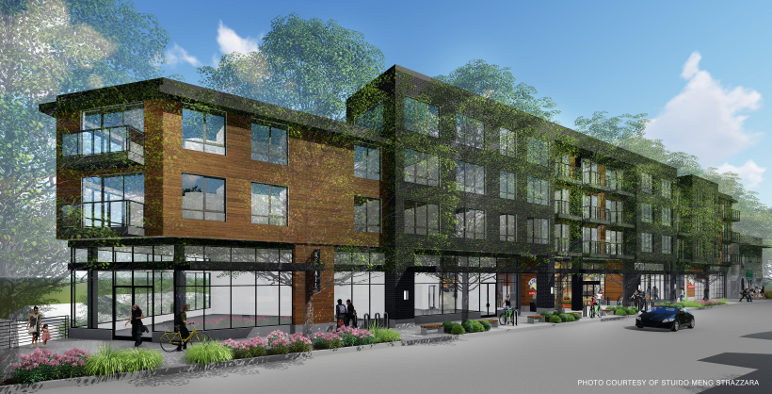
Madison Valley Apartments and PCC Supermarket (2925 East Madison St)
One more to watch is this 73-unit apartment and supermarket project that has spawned heated opposition from neighbors, who went so far as to hire a paid consultant. The board has so far required two extra meetings, primarily concerning the sloping transition to a single-family zone on the back side of the property. Now that the developer has resolved that issue by placing townhouses facing the single-family zone, it remains to be seen whether the board will demand yet another meeting, egged on by a room full of neighbors some of whom are likely motivated to simply shut down any building proposal whatsoever.
Seattle’s proposed design review improvements need improvement
In accordance with Seattle’s HALA recommendation to reduce design review’s negative impact on housing affordability for both conventional and subsidized housing, city planners proposed a package of improvements intended to make the process more efficient and predictable. The proposal includes some much-needed revisions, but overall it falls short—by a lot. If adopted as proposed, it will be a hollow victory for affordability.
I submitted a detailed comment letter on the proposal to City Council that identifies flaws and suggests fixes, and I include it as an appendix to this article. Here are the key points:
- The proposal adjusts the building size thresholds for design review, but the net result would be only a minor reduction in the number of small projects that must wend their way through review.
- The proposal creates a new “hybrid” form of design review entailing early design guidance by city staff and design recommendation by the board. This hybrid may well prove more dysfunctional and time consuming than current full design review, because, inevitably, city staff reviewers and board members will sometimes contradict each other. Because the two review steps are conducted at different points in the process, it’s unclear how such conflicts would be resolved.
- The proposal would eliminate streamlined design review, which would be a step backward. It has been working well for small-scale projects.
- The proposal would limit the number of board meetings, but the limit is so riddled with exceptions that it’s nearly meaningless. For one, the limit is void for any project that is pursuing a departure, and most projects do. In all cases, the city can require additional meetings if “the board needs more time for deliberation.”
- The proposal adds a new requirement for upfront community outreach, which constitutes an added burden on new housing construction—especially small projects—and is directly contrary to the letter and spirit of the HALA recommendation.
A counter proposal
In short, the city’s proposal would not reduce design review’s burden nearly enough. In fact, the city’s analysis overstates the proposal’s potential efficacy because it’s calculated in terms of the number of homebuilding projects rather than the number of homes. The proposed changes would apply more frequently to smaller buildings, so the share of individual homes affected would be much smaller than the share of projects affected.
The following alternative scheme would take the program much closer to where it needs to go (thresholds based on the size of the building measured in square feet):
- Up to 15,000 sf: Exempt from design review
- 15,000 to 25,000 sf: Streamlined design review
- 25,000 to 50,000 sf: Administrative design review
- Greater than 50,000 sf: Full design review
This scheme would:
- Exempt a greater number of “missing middle” projects such as townhouses and small apartment buildings, which, compared to larger projects, have less impact on the community yet suffer a proportionally greater financial hit from design review;
- Retain streamlined design review, which is effective for modest projects and is appropriate for the first tier above the exemption threshold;
- Expand the use of administrative design review, applying it as the next tier up from streamlined review for medium-scale projects (apartment buildings from about 30 to 60 units);
- Reject the proposed hybrid design review because it is an untested scheme rife with the risk of failure;
- Retain full design review—with a strict two-meeting limit—for large-scale projects, which tend to have the greatest potential community impacts, and can more easily withstand the financial burden of the process; and
- Reject the requirement for additional early outreach, but offer it as an option supported by city staff.
These revisions would make Seattle’s program more like design review in Portland, a city nationally recognized for quality architecture and urban design. Compared to Seattle, in Portland a greater share of modest projects are only subject to internal administrative review by city staff, and the city is currently considering changes to the program that would further “lessen the level of review for smaller projects.”
For larger developments, the Portland’s design review process is limited to a single public meeting with its Design Commission, a citywide board of seven appointed volunteers. The commission’s decision can be appealed, which triggers a second public meeting at which the city council makes the final call. In some cases developers can choose to opt out of design review if they are confident that their project indisputably meets all of the city’s design rules.
Is a volunteer board incompatible with design review?
Seattle’s proposal recommends additional training for design review board members, a worthwhile step toward more consistent, defensible decision making. Unfortunately the proposal leaves unmentioned the specific critical need for education on the relationships among building design, construction cost, and housing affordability.
But this leads to a bigger question: is the volunteer board format a fatal flaw? Is it sensible to put the massive responsibility of adjudicating billions of dollars of real estate investment on the shoulders of volunteers, no matter how smart and well-intentioned they may be?
Education helps, but because so much about design is subjective, no amount of training is going to eliminate unpredictable variation of opinions among board members. Homebuilders will always face a crap shoot with the people who hold veto power over their projects, and that uncertainty is poison to private development. In a city with spiraling prices caused by a lack of homes, the potential for a more radical overhaul of design review—including axing the volunteer boards—deserves serious attention. After all, as noted by city planners, “Seattle is one of the only large cities in the U.S. where design review is conducted by primarily neighborhood-based citizen-volunteer boards.”
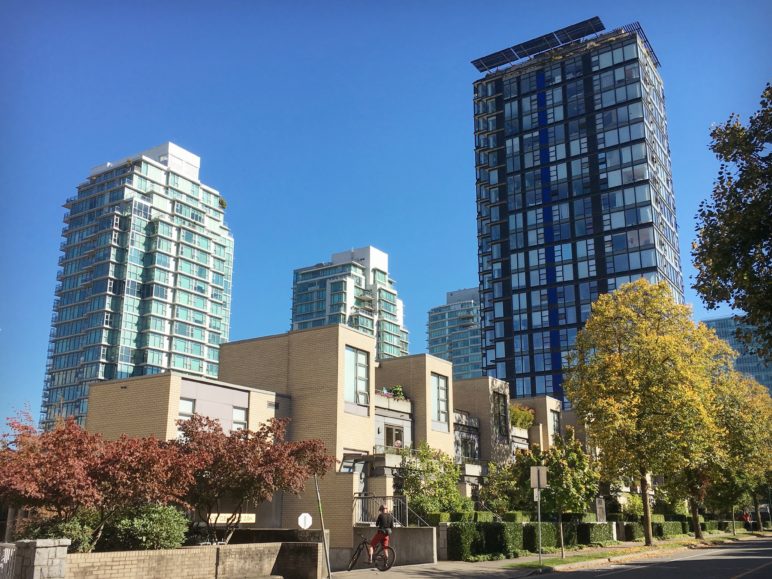
In Vancouver, BC, design proposals for large developments are approved by a “Development Permit Board” made up of four senior city staff members. Proposals are first assessed by city planners who provide a recommendation to the board. The board then conducts a public meeting with a nine-member citizen advisory panel, at which the developer and any other interested parties can provide comment. At the conclusion of the meeting, the board makes a final decision by vote. The proof is in the city: Vancouver is internationally known as one of the most livable large cities on the planet, and its architecture has a reputation that far exceeds Seattle’s.
In the near term it’s a good first step for Seattle to make incremental changes to design review. But Cascadia’s first city should also explore the more radical option of converting to a system like Cascadia’s second city (Vancouver), in which dedicated, highly trained city staff make the decisions, minimizing the delay and uncertainty that is so toxic to homebuilding.
Conclusion
Seattle has rightly called out its design review program as an impediment to construction of the new homes the city so desperately needs to relieve its shortage and ease rents. Unfortunately, the city’s proposed changes to design review are far too modest, and a much more aggressive set of reforms is needed to achieve the affordability goals of the city’s HALA recommendations. City policymakers can improve the proposal with higher thresholds and reorganization of design review types. Ultimately, however, the best solution for design review in Seattle and other high-cost cities may be to end reliance on volunteer boards and hand over the job to professional city staff.
UPDATE:
On 9/7/17 Seattle City Council introduced amendments to the design review proposal. As described in Sightline’s comment letter to Council in response, some of the amendments would help, but the proposal would still fall short on meeting the intent of the HALA recommendation to improve affordability in Seattle.
Notes
Seattle City Council’s Planning, Land Use & Zoning Committee will discuss the proposed design review improvements on Friday, September 8, 2017, 9:30 a.m. in Council Chambers, Seattle City Hall, Floor 2, 600 Fourth Avenue.
Seattle City Council will hold a public hearing on the proposed improvements to design review on Monday, September 11, 2017 at 7:00 p.m. at SIFF Cinema Uptown, Auditorium 3, 511 Queen Anne Avenue N. (map). West Seattle Blog has posted a summary of the comments and the video.
Exemplifying how delay breeds uncertainty, the Columbia City project discussed above was initiated before Seattle proposed its Mandatory Housing Affordability (MHA) program, yet it will now be required to participate. And during the time the project was stuck in the design review process the MHA requirements were raised twice, from five to six, and finally, to nine percent subsidized units.
Below is the full text of Sightline’s comment letter to the Seattle City Council on the proposed improvements to Design Review (pdf here):
August 4, 2017
RE: Proposed improvements and administrative updates to the Design Review Program (Council Bill number not yet assigned)
Dear Councilmembers:
I am writing to provide the Sightline Institute’s comments on the proposed updates to the city’s Design Review (DR) program. We applaud the city’s intent to modify the DR program with the goal of increasing housing affordability, as articulated in the Mayor’s Housing Affordability and Livability Agenda (HALA).
We strongly support the following proposed changes to the DR program:
- Change of the exemption threshold metric from housing units to total building square footage (particularly important for lowrise apartments because their units are smaller than for-sale units.)
- 10,000 sf threshold that exempts most townhouse projects, correcting current DR requirements that have quashed townhouse production in favor of single-family clusters (link).
- Requirement for only Administrative Design Review for 100% affordable projects.
However, we believe that numerous components of the proposal must be modified for the changes to yield significant progress toward HALA’s affordability goals. Overall, we believe that the proposal doesn’t go nearly far enough to reduce the negative impact of DR on the cost of homebuilding.
Council now has a rare opportunity to help address the city’s affordability crisis through administrative changes that would cost virtually nothing to the city. To maximize this opportunity, we urge Councilmembers to consider the following concerns and set of eight recommendations.
Hybrid DR
In theory, the proposed Hybrid process is a good step for reducing the burden of DR. However, as proposed, Hybrid DR introduces the risk of a project getting the internal green light from city staffers at EDG, but then getting held back at the subsequent Recommendation Meeting by a Design Review Board (DRB) with conflicting opinions. In such cases, Hybrid DR could in fact prove more onerous than today’s Full DR. We believe that the reverse order—conduct the EDG meeting with the DRB first, and then the Recommendation Meeting with city staff—is likely to be more productive. But we also recognize the risk that if the DRB meeting comes first, DRB members may object to the fact that their input could be overridden in a subsequent meeting with staff. The proposal would allow up to 25 projects to participate in a one-year pilot in which DRB would come first and staff review second. But why impose this limit? Allowing all applicants to freely choose the meeting order would, over time, reveal which order is more beneficial, and lead to the best outcome for the program.
RECOMMENTATION #1: For Hybrid DR, make the meeting order a permanent optional choice for applicants.
Limit on DR Meetings
We support the proposed two-meeting limit on the number of DR meetings, but as proposed it will apply in few cases because it is void for projects that are pursuing departures. To a typical developer, one of the most valuable aspects of Seattle’s DR process is the opportunity it provides to pursue departures, and most projects do. The meeting limit is also voided if a project is located adjacent to a single-family zone, granting unjustified priority for public input to what is on average a relatively privileged portion of the city’s residents. Furthermore, additional meetings can be required by the SDCI Director if the DRB needs more time for deliberation. With all these exceptions, the meeting limit has no “teeth” in most cases, and therefore will not in practice achieve its intent to reduce development delay and uncertainty.
RECOMMENTATION #2: Remove all the exceptions to the two meeting limit, with a provision that if decisions cannot be made in two meetings, the case goes immediately to the SDCI Director for a final decision.
Complexity Designation for Context
We oppose the proposal for two levels of project complexity according to “context” for the following reasons:
- First and foremost, any needs for special design considerations around zone transitions ought to be handled by design standards in the land use code, not by DR.
- It grants inequitable preference to residents of single family zones by providing more opportunity to give feedback on projects through more extensive DR. Why do people who live in single-family zones deserve what is in effect special treatment from the city in terms of the attention paid to the design of adjacent development?
- It is likely to disproportionately impact projects in lowrise zones because they are often adjacent to single-family zones.
- It adds, well, complexity, to the DR process that is likely to create unintended consequences, such as development favoring sites not on zone boundaries.
RECOMMENTATION #3: Eliminate the non-complex/complex designation by “context,” and apply the thresholds as currently proposed for non-complex projects.
Complexity Designation for Scale
We oppose the proposal to classify projects as complex if their façade length exceeds 200 feet. The city already has design standards intended to regulate the design of long building facades. Imposing a more intensive design review process for long facades is redundant. Forcing full design review on more projects in this way contradicts the primary goal of the proposal. Furthermore, a 200-foot limit would trigger full design review for most projects on lots as small as 20,000 sf, since lots are commonly 100 feet deep. The cost of design review disproportionately harms these smaller scale, lower cost projects. If a façade length threshold is deemed necessary, then it should be set at no less than 300 feet.
RECOMMENTATION #4: Eliminate the complexity designation by façade length, and apply the thresholds as currently proposed for non-complex projects.
DR Thresholds
For lowrise ownership homes other than townhouses, the proposed 10,000 sf threshold is effectively lower than the current 8-unit threshold (8 units x 1500 sf/unit = 12,000 sf). So for example, a 7-unit rowhouse that would be exempt from DR today would trigger DR under the proposal. For typical lowrise apartments, the 10,000 sf threshold is higher than the current 8-unit threshold (8 units x 800 sf/unit = 6,400 sf), but that won’t make much difference to DR exemptions in practice because most lowrise apartments are greater than 10,000 sf anyway.
On page 7 the June 2017 Director’s Report states that the 10,000 sf threshold was chosen because it
“approximates the size of development on two typical lots in a lowrise zone.” That is incorrect. Typical lots in lowrise zones are 5,000 sf (former single-family lots), so on two of these lots any lowrise project will be greater than 10,000 sf, triggering a DR requirement. This represents a large share of potential “missing middle” housing projects in the city, as illustrated in the city’s MHA Urban Design and Neighborhood Character Study (link). Furthermore, the cost burden of DR falls more heavily on these smaller projects.
Under the proposal, lowrise projects from 10,000 to 20,000 sf would be downgraded from Full DR to Administrative or Hybrid, depending on the complexity designation. Projects > 20,000 sf would be subject to Hybrid or Full DR, also depending on complexity. In sum, the proposal would yield a beneficial reduction in DR encumbrance on townhouses and small apartments, but for other lowrise types the net benefits are likely to be marginal.
For congregate/SEDU, the proposal would exempt projects from 5,000 to 10,000 sf that are currently subject to Streamlined DR. But it would also subject projects from 10,000 – 12,000 sf to Administrative DR, which is more rigorous than Streamlined DR. For congregate/SEDU projects from 12,000 to 20,000 sf, the proposal would require either no change from the current Administrative DR, or a step up to the more rigorous Hybrid DR if the project was deemed complex. Congregate/SEDU projects > 20,000 sf would step down to Hybrid DR or would stay at Full DR, depending on complexity. All told, for congregate/SEDU the proposed threshold changes are a mixed bag, and would likely have only a marginal effect on reducing the encumbrance of DR.
For MR, HR, and SM zones, the proposed 10,000 sf threshold is lower than the existing 20-unit threshold (20 units x 800 sf/unit = 16,000 sf). For NC zones, the proposed 10,000 sf threshold is higher than the current threshold, but in practice the proposed threshold would exempt only a small fraction of NC projects from DR because most are larger than 10,000 sf anyway. Most projects in MR, HR, SM, and NC zones are > 20,000 sf, for which the proposal would require Hybrid or Full DR, depending on complexity. MR or SM projects smaller than 20 units but greater than 10,000 sf are currently exempt, but would become subject to DR under the proposal. Again, a mixed bag overall.
RECOMMENTATION #5: Increase the base threshold for DR to at least 15,000 sf. As described above, the proposed 10,000 sf threshold may be higher or lower than existing thresholds, depending on project specifics. We believe that a higher threshold is necessary for the policy change to achieve its desired effect of significantly decreasing the DR burden. A higher threshold is also justified by the fact that DR places a proportionally larger burden on small projects because the cost of DR is a larger fraction of the total project cost.
Analysis of Proposal
The city’s analysis on page 16 of the June 2017 Director’s Report shows that 28% of projects that were subject to DR in 2014-2015 would be exempt under the proposal. Of those, the vast majority (26% of the 28%) are projects that were subject to Streamlined DR, currently the simplest form of DR, and most of these were townhouses (presumably a small fraction were congregate/SEDUs between 5,000 and 12,000 sf). So in terms of DR exemption, for the most part the proposed 10,000 sf threshold in effect only reverts the DR Program back to how it was before 2010 when the city singled out townhouses for a new DR requirement—that is, it barely moves the needle much past where it was pre-2010. These results support Recommendation #5 (see above) to raise the base threshold.
A little more than a third of the projects currently subject to Full DR would become subject to a less rigorous DR process: 26% would go to Hybrid, 8% to Administrative, and 2% to exempt. This outcome would support the intent of the proposed policy changes, however we believe that it doesn’t go far enough to achieve the need for reducing the cost of homebuilding. Lastly, the impact of the proposal on the relatively small number of projects currently subject to Administrative DR is basically a wash.
Because the city’s analysis is based on number of projects rather than number of unit, it overstates the impact of the proposal on housing production (the city did not publish data on units). Nearly all of the projects that would be exempted under the 10,000 sf threshold are small projects with low unit counts. In terms of the number of units, the percentage exempted would be far less than 28% of projects that were exempted. Likewise, most of the projects that would be downgraded from Full DR would move because they are relatively small, and therefore have fewer units compared the average Full DR project. In terms of units, the fraction that would become subject to a DR process less rigorous than Full DR is lower than the 36% of projects that would.
RECOMMENTATION #6: To get a more accurate assessment of the proposal’s impact on housing production, analyze it in terms of the number of units, not just the number of projects.
Optimum Design Review Scheme
We believe the current proposal misses the mark by a wide margin. For changes to DR to yield significant movement toward achieving the goals of HALA and a sustainable city overall, the proposal needs major adjustments.
RECOMMENTATION #7: Restructure the DR program as follows:
0 – 15,000 sf: no DR
15,000 – 25,000 sf: Streamlined DR
25,000 – 50,000 sf: Administrative DR
> 50,000 sf: Full DR
Some explanation: Streamlined DR has proven to be an effective process for smaller projects, and we believe it makes sense for it to apply to the first tier of projects above the DR exemption threshold. Hybrid DR as proposed is rife with the risk of failure due to the inherent disconnect between the DRB meeting and the city staff meeting, regardless of the order in which it occurs. Administrative DR is appropriate for small-to-medium scale projects that need deeper assessment but because of their smaller scale are more severely impacted financially by the cost and uncertainty caused by a DR process that puts the project in front of multiple public meetings. Full DR is best suited for large-scale projects. Threshold adjustments for complexity could be added as desired (but not for “context,” as discussed above).
Early Community Outreach
We strongly oppose the proposal for additional early-stage community outreach. Such a requirement that adds loosely-defined and time-consuming additional process to DR is diametrically opposed to the policy goals to reduce the encumbrance of DR in order to promote affordability. It would also disproportionately hurt small-scale projects, because the cost would take a bigger bite out of the budget. Larger projects are already required to provide community outreach through public DR meetings. This component of the proposal egregiously contradicts the stated goals and recommendations of HALA.
RECOMMENTATION #8: Eliminate the proposed requirement for additional early community outreach.
Miscellaneous additional recommendations
- The official goals of Design Review should be appended to emphasize recognition of its impact on homebuilding cost and supply, not only by the process itself, but through added costs imposed by changes mandated through the DR process, such as setbacks or more expensive façade materials. For example, reviewers could be instructed to consider strategies that make housing more plentiful, more affordable, or better serve communities at risk of displacement.
- Make height and floorplate departable through DR (though this would likely require changes to the land use code). Such flexibility—likely involving a trade-off the two parameters—would allow for much more creative design, and much less of a monotonous city skyline.
Thank you for the opportunity to provide comments. We look forward to further involvement in crafting the best possible set of improvements for Design Review.
Sincerely,
Dan Bertolet
Senior Researcher
Sightline Institute
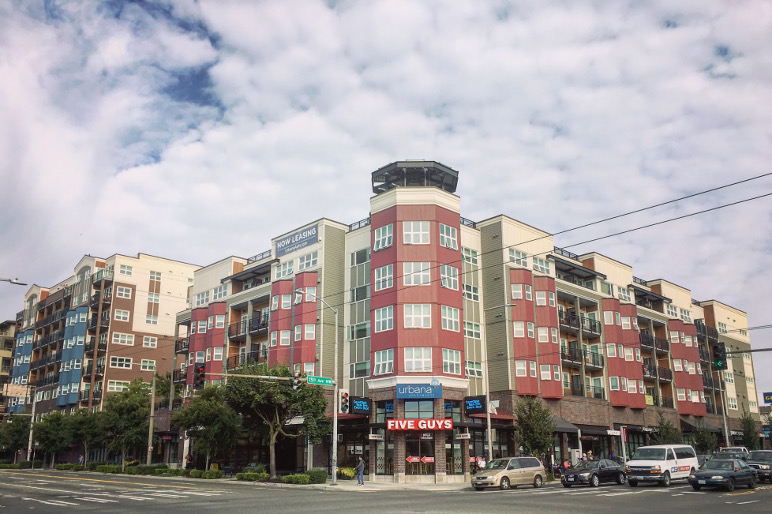

Comments are closed.